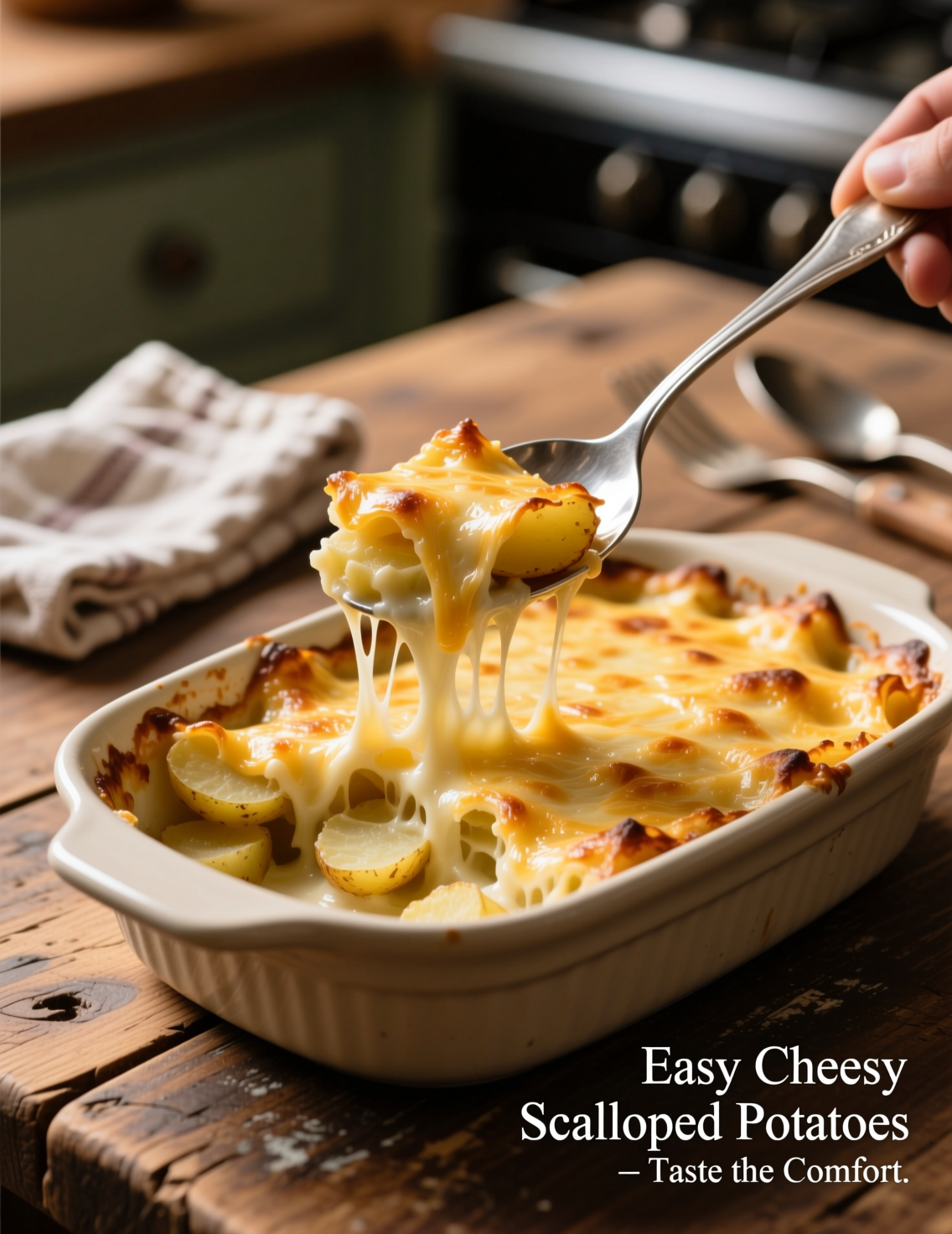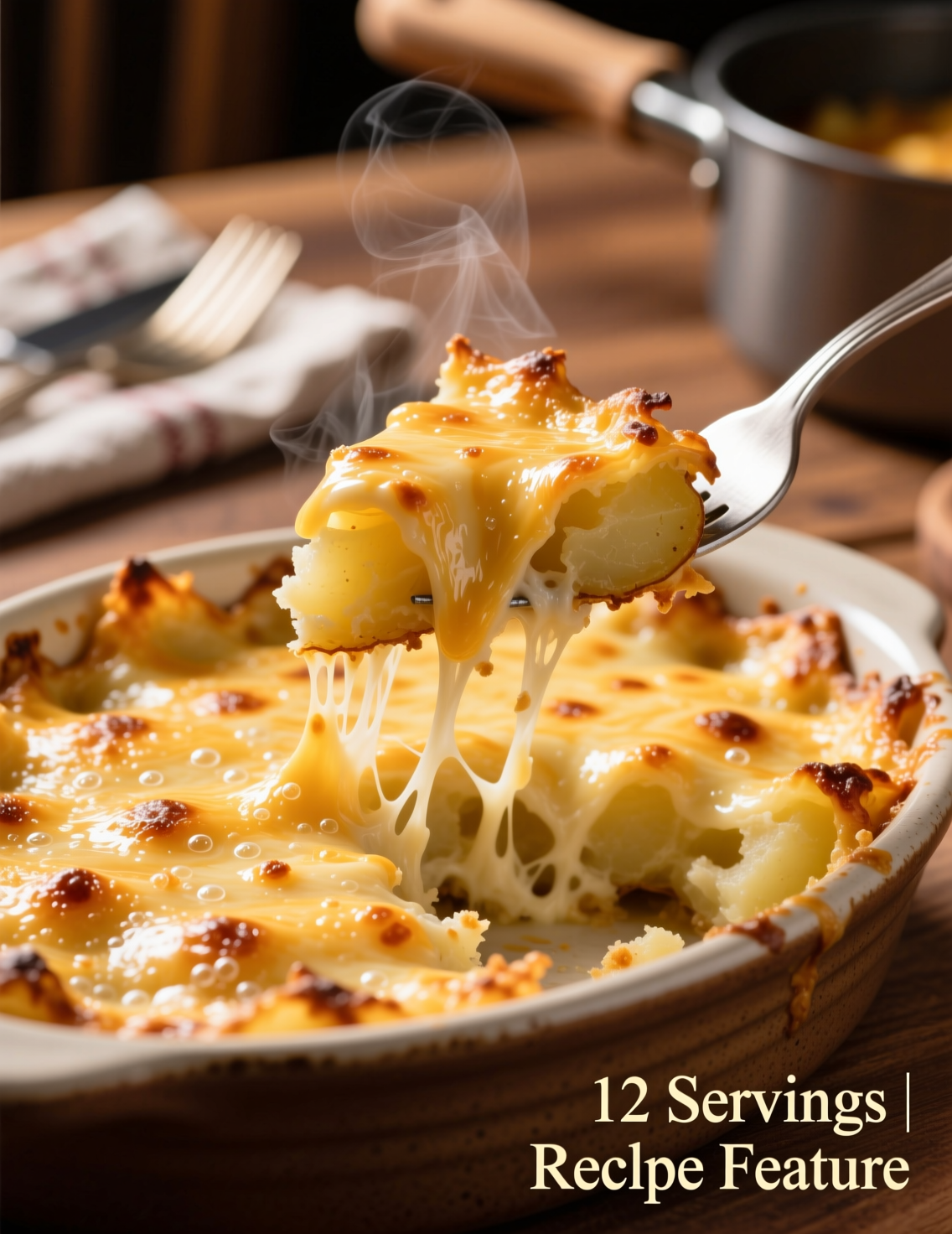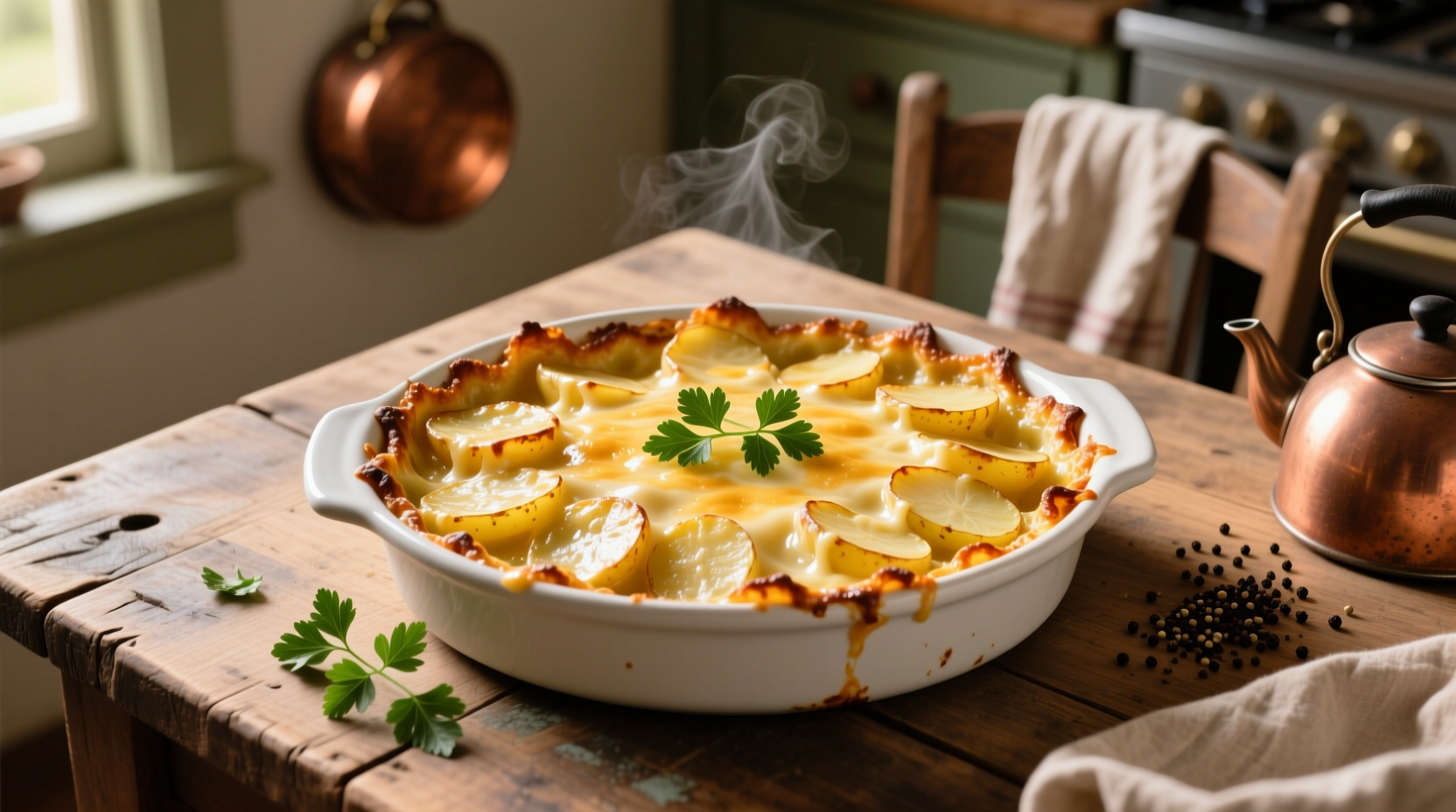If you’ve ever craved a creamy, cheesy comfort dish that hits all the right notes, scalloped potatoes are your go-to. And we’re not talkin’ the thin, shy version—you want a dish that’s rich, decadent, and just the right amount of ooze. This article dives deep into crafting the ultimate Easy Cheesy Scalloped Potatoes Recipe serving twelve, giving insights that will elevate your culinary game from home cook to kitchen wizard.
Understanding Scalloped Potatoes: A Professional Overview
Scalloped potatoes, for many chefs, are a deceptively simple dish. On the surface, it’s layers of sliced potatoes baked with cream and cheese. But the beauty lies in the balance—texture, flavor, and the caramelized edges. A small misstep in starch content, layering, or cheese selection can lead to a dish that’s either gluey or bland. Historically, scalloped potatoes date back to the 17th century, where cooks layered thin potatoes with cream and butter in earthenware. Today, the dish has evolved, but the core principles remain.
The starch in the potato is critical. Russets and Yukon Golds are top choices. Russets provide fluffiness and absorb cream beautifully, but can overcook easily. Yukon Golds bring a waxy, buttery texture that’s more stable during baking. For professionals aiming for a creamy yet firm structure, a mix of both yields perfection.
Ingredients Matter: Choosing the Right Components
For twelve servings, ingredient precision is crucial. Here’s a breakdown of what makes the magic happen:
- Potatoes: 6 pounds of mixed Russet and Yukon Gold, peeled and sliced 1/8–1/4 inch thick. Consistent thickness ensures even cooking.
- Cheese: Sharp Cheddar (3 cups) and Gruyère (2 cups) shredded. Sharp cheeses give depth, while Gruyère adds a nutty complexity.
- Cream: 2 cups heavy cream plus 1 cup whole milk. This ratio keeps richness without excessive heaviness.
- Butter: 1/2 cup unsalted butter, diced. Browning it slightly before combining can intensify flavor.
- Seasonings: Salt, white pepper, garlic powder, and a pinch of nutmeg. Nutmeg is subtle but brings an earthy warmth that balances dairy richness.
Many amateurs skip Gruyère or nutmeg. As a pro, I insist on these—they elevate the dish from basic to memorable.

Prep Techniques: Slicing, Layering, and Beyond
A precise approach here defines the final dish. Use a mandoline for uniform slices. Uneven slices cause uneven cooking; you risk some layers mushy while others resist tenderness. Layering matters too: alternate potato layers with cheese and seasoning, ensuring each slice touches creamy goodness. Overlapping edges slightly encourages proper melding.
Sprinkle cheese strategically—too much at the bottom can cause burning; too little at the top can prevent that golden, bubbly crust everyone loves. And don’t shy away from seasoning between layers. It’s easy to under-season in multi-layer dishes, which results in a flat flavor profile.
Sauce Mastery: Cream vs. Bechamel
While some recipes call for a simple cream pour, professionals often prefer a lightly thickened sauce for better adhesion. Make a beurre manié (equal parts butter and flour) and whisk into warmed cream and milk to form a loose bechamel. This prevents cheese from sliding off and ensures luscious, clingy layers.
A subtle trick: add half the cheese into the sauce itself, leaving the rest for layering. This guarantees that cheesy flavor infuses every bite, not just the surface. Many home cooks toss all cheese on top—results can be visually appealing, but structurally weak.
Baking Insights: Temperature and Timing
Baking is more than “just until golden.” Start at 375°F for 20 minutes covered with foil. This gentle heat allows potatoes to absorb sauce without drying. Remove foil and bake an additional 30–40 minutes to develop a caramelized crust.
Check doneness with a small knife; it should glide through layers effortlessly. A fork-only test can mislead, as top layers might be done while the center lags. For large 12-serving casseroles, consider 5–10 minutes extra per inch of depth.
Cheese Crust Perfection: Professional Tips
Golden bubbly cheese isn’t luck—it’s technique. For even browning, broil for the final 2–3 minutes, rotating pan halfway. Keep a close eye; cheese can go from perfectly bubbly to scorched in seconds.
Tip: sprinkle a touch of Parmesan on top for nutty complexity. It crisps differently than Cheddar and Gruyère, giving a visually appealing, crunchy top layer. It’s a subtle chef move that signals intentionality.
Serving Strategies and Presentation
Scalloped potatoes are often overlooked in plating. Professional kitchens treat it as both a side and a star. Garnish with fresh thyme or chives to cut richness visually and flavor-wise. For 12 servings, a shallow, wide dish works better than a deep one—maximizes crispy edges and reduces uneven cooking.
Leftovers? Slice into portions, cool completely, and reheat in the oven covered at 350°F to maintain texture. Microwave reheating often leads to rubbery edges—an avoidable amateur mistake.
Common Pitfalls and How to Avoid Them
- Mushy potatoes: Slice too thin or use starchy-only varieties. Solution: mix Russets with waxy potatoes.
- Watery casserole: Not enough sauce thickening or uneven layering. Solution: use light bechamel and ensure cheese and cream are evenly distributed.
- Burnt top layer: Oven too hot or uncovered too early. Solution: follow foil covering first, broil only at the very end.
Even seasoned chefs occasionally miscalculate bake times with large batches. Use toothpick testing and visual cues rather than relying solely on recipe times.
Expert Variations to Elevate the Dish
- Herb-infused cream: Add rosemary or thyme sprigs while heating cream, remove before layering. Infuses subtle aromatic depth.
- Bacon or pancetta: Crispy diced bacon between layers adds smokiness. A tip: cook until just golden, not burnt, to avoid overpowering the delicate potatoes.
- Caramelized onions: Layer thinly sliced onions sautéed until golden for a sweet contrast. Works particularly well with Gruyère.
These variations show that scalloped potatoes are more than a side—they’re a canvas. You can adapt based on seasonality, dietary preferences, or plating style without compromising structural integrity.
Nutritional Insights for Larger Portions
A full casserole serving (1/12th) approximates:
- Calories: 350–400 kcal
- Fat: 22g
- Carbs: 32g
- Protein: 12g
Use lower-fat dairy or swap half the cream for milk to reduce calories slightly. Adding a layer of thinly sliced cauliflower can cut carbs while maintaining a creamy texture—an advanced professional tweak for health-conscious diners.

Trends in Scalloped Potatoes
Modern chefs experiment with global twists. Truffle oil drizzle post-bake is trending in upscale eateries. Vegan versions with cashew cream and plant-based cheeses are gaining traction. Even molecular gastronomy approaches deconstruct scalloped potatoes, presenting components in layered cylindrical portions.
For home cooks, keeping the classic technique while exploring subtle flavor enhancers like smoked paprika or roasted garlic is practical and impressive. It’s a trend-forward way to elevate tradition without overcomplicating.
Frequently Asked Questions
Can I prepare this ahead?
Absolutely. Assemble the dish up to 24 hours in advance, cover tightly, and refrigerate. Bake as usual, adding 5–10 minutes to compensate for chilled ingredients.
Can I freeze scalloped potatoes?
Yes, fully baked and cooled portions can be frozen up to 2 months. Reheat gently in the oven to preserve texture.
What cheese combinations work best?
Sharp Cheddar plus a nutty, melting cheese like Gruyère is classic. Fontina or Emmental also work well. Avoid pre-shredded cheeses with anti-caking agents—they affect melt quality.
Can I prepare scalloped potatoes ahead of time?
Yes, assemble up to 24 hours in advance and bake, adding extra time for chilled ingredients.
Can scalloped potatoes be frozen?
Yes, fully baked portions freeze up to 2 months; reheat gently in the oven to maintain texture.
What types of potatoes work best?
A mix of Russet and Yukon Gold ensures creamy yet firm layers with perfect texture.
Which cheeses are ideal for this recipe?
Sharp Cheddar and Gruyère are classic; Fontina or Emmental also melt beautifully without overpowering flavor.
How can I prevent watery scalloped potatoes?
Use a light bechamel sauce, evenly distribute cheese, and layer potatoes consistently to avoid excess moisture.
How do I achieve a golden cheese crust?
Bake covered first, then broil 2–3 minutes at the end while watching closely for perfect browning.
Can I add flavor variations?
Yes, try herbs, caramelized onions, bacon, or truffle oil to elevate the dish without compromising texture.
What’s the best way to slice potatoes?
Use a mandoline for uniform slices, 1/8–1/4 inch thick, ensuring even cooking and creamy layers.
Are there lower-fat alternatives?
Swap half cream for whole milk or add thinly sliced cauliflower to reduce calories and maintain creaminess.
How large should the baking dish be for 12 servings?
A shallow, wide dish is ideal for even cooking and maximizing crispy edges.
Conclusion: Elevating Scalloped Potatoes to Culinary Art
Crafting the ultimate Easy Cheesy Scalloped Potatoes for 12 servings is about more than following a recipe—it’s about understanding textures, balancing flavors, and mastering technique. Choice of potatoes, cheese quality, sauce consistency, and careful baking dictate the outcome. By layering thoughtfully, using a light bechamel, and finishing with precise broiling, you achieve a dish that’s creamy, flavorful, and visually stunning.
This dish can stand alone as a centerpiece or complement any festive spread. Professionals and ambitious home cooks alike can benefit from small tweaks—herbs, caramelized onions, or bacon—to make it truly unforgettable. Next time you plan for a dozen servings, remember: patience, precision, and a little cheesy daring go a long way.

Mariana is a passionate home cook who creates delicious, easy-to-follow recipes for busy people. From energizing breakfasts to satisfying dinners and indulgent desserts, her dishes are designed to fuel both your body and hustle.
When she’s not in the kitchen, she’s exploring new flavors and dreaming up her next recipe to share with the Foodie Hustle community.

